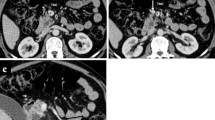Abstract
The mesentery and the omentum are the main fatty tissues in the abdomen. Various pathologic conditions such as benign and malignant neoplasm, inflammatory process, and traumatic lesions may involve the mesentery and the omentum. Differentiation of some lesions, whether they are in the mesentery or the omentum, is very important for accurate diagnosis and proper treatment. Vascular structures are important anatomical landmarks to determine the intraperitoneal fat plane accurately. The superior mesenteric artery and vein run through the small bowel mesentery. The middle colic artery and vein run through the transverse mesocolon. The sigmoid and superior rectal vessels run through the sigmoid mesocolon. Among various neoplastic diseases that involve the mesentery and the omentum, secondary neoplasms are more frequent than primary ones. Sclerosing mesenteritis, tuberculosis, and traumatic lesions may involve the mesentery. Tuberculosis, traumatic lesions, infarction, and torsion can occur in the omentum. Multidetector computed tomography (MDCT) images are valuable for the exact location of pathologic conditions by use of multiplanar reformatted images.



















Similar content being viewed by others
References
Bernardino ME, Jing BS, Wallace S (1979) Computed tomography diagnosis of mesenteric masses. AJR Am J Roentgenol 132:33–36
Conzo G, Vacca R, Grazia Esposito M, Brancaccio U, Celsi S, Livrea A (2005) Laparoscopic treatment of an omental cyst: a case report and review of the literature. Surg Laparosc Endosc Percutan Tech 15:33–35
DeMeo JH, Fulcher AS, Austin RF Jr (1995) Anatomic CT demonstration of the peritoneal spaces, ligaments, and mesenteries: normal and pathologic processes. Radiographics 15:755–770
Einstein DM, Tagliabue JR, Desai RK (1991) Abdominal desmoids: CT findings in 25 patients. AJR Am J Roentgenol 157:275–279
Federle MP, Guliani-Chabra S (2004) Peritoneum, mesentery, and abdominal wall. In: Federle MP (ed) Diagnostic imaging: abdomen. Amirsys. pp 46–47
Grattan-Smith JD, Blews DE, Brand T (2002) Omental infarction in pediatric patients: sonographic and CT findings. AJR Am J Roentgenol 178:1537–1539
Hamrick-Turner JE, Chiechi MV, Abbitt PL, Ros PR (1992) Neoplastic and inflammatory processes of the peritoneum, omentum, and mesentery: diagnosis with CT. Radiographics 12:1051–1068
Heiken JP, Aizenstein RI, Balfe DM, Gore RM (2000) Peritoneal cavity and retroperitoneum: normal anatomy and examination techniques. In: Gore RM (ed) Textbook of gastrointestinal radiology, 2nd edn edn. Saunders, Philadelphia, pp 1930–1939
Horton KM, Lawler LP, Fishman EK (2003) CT findings in sclerosing mesenteritis (panniculitis): spectrum of disease. Radiographics 23:1561–1567
Jadvar H, Mindelzun RE, Olcott EW, Levitt DB (1997) Still the great mimicker: abdominal tuberculosis. AJR Am J Roentgenol 168:1455–1460
Jeon YS, Cho SG, Kim WH, Kim MY, Seo CH (2004) CT findings of primary torsion of the greater omentum with segmental infarction: case report. J Korean Radiol Soc 50:437–440
Jorgensen M, Prokop M (2003) Peritoneal cavity and retroperitoneum. In: Prokop M, Galanski M (eds) Spiral and multislice computed tomography of the body. Thieme, New York, pp 595–624
Maeda T, Mori H, Cyujo M, Kikuchi N, Hori Y, Takaki H (1997) CT and MR findings of torsion of the greater omentum. Abdom Imaging 22:45–47
Magid D, Fishman EK, Jones B, Hoover HC, Feinstein R, Siegelman SS (1984) Desmoid tumors in Gardner syndrome: use of computed tomography 142:1141–1145
Milic DJ, Rajkovic MM, Zivic SS (2004) Primary liposarcomas of the omentum: a report of two cases. Eur J Gastroenterol Hepatol 16:505
Moore KL (1982) The developing human: clinically oriented embryology , vol 3rd edn. WB Saunders, Philadelphia, pp 227–254
Mueller PR, Ferrucci JT Jr, Harbin WP, Kirkpatrick RH, Simeone JF, Wittenberg J (1980) Appearance of lymphomatous involvement of the mesentery by ultrasonography and body computed tomography: the “sandwich sign”. Radiology 134:467–473
Okino Y, Kiyosue H, Mori H, Komatsu E, Matsumoto S, Yamada Y, Suzuki K, Tomonari K (2001) Root of the small-bowel mesentery: correlative anatomy and CT features of pathologic conditions. Radiographics 21:1475–1490
Silverman PM, Baker ME, Cooper C, Kelvin FM (1986) CT appearance of diffuse mesenteric edema. J Comput Assist Tomogr 10:67–70
Silverman PM, Cooper C (2000) Mesenteric and omental lesions. In: Gore RM (ed) Textbook of gastrointestinal radiology, 2nd edn edn. Saunders, Philadelphia, pp 1980–1990
Silverman PM, Osborne M, Dunnick NR, Bandy LC (1988) CT prior to second-look operation in ovarian cancer. AJR Am J Roentgenol 151:713–715
Sompayrac SW, Mindelzun RE, Silverman PM, Sze R (1997) The greater omentum. AJR Am J Roentgenol 168:683–687
Suri S, Gupta S, Suri R (1999) Computed tomography in abdominal tuberculosis. Br J Radiol 72:92–98
Author information
Authors and Affiliations
Corresponding author
Rights and permissions
About this article
Cite this article
Jeon, Y.S., Lee, J.W. & Cho, S.G. Is it from the mesentery or the omentum? MDCT features of various pathologic conditions in intraperitoneal fat planes. Surg Radiol Anat 31, 3–11 (2009). https://doi.org/10.1007/s00276-008-0381-y
Received:
Accepted:
Published:
Issue Date:
DOI: https://doi.org/10.1007/s00276-008-0381-y




